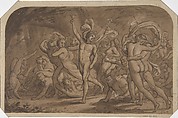Milton's Comus
Sir Joseph Noël Paton British, Scottish
Relates to John Milton British
Not on view
Milton centered his masque "Comus" on a mythic figure that he called the son of Bacchus, and used to embody frenzied revelry. Here, he leads riotous followers through the woods at night–some sporting animal heads. Paton came to London from Scotland to attend the Royal Academy Schools in 1843 and soon was commissioned to illustrate two poems in Samuel Carter Hall's "Book of British Ballads" (1842-43). This drawing, with its free pen work and emphasis upon the nude, likely was produced a year or two later. By 1848, Paton adopted a tighter style influenced by the Pre-Raphaelites (as a friend of John Everett Millais since student days, Paton was invited to join brotherhood, declined formal membership, was sympathetic to their tenets).
Due to rights restrictions, this image cannot be enlarged, viewed at full screen, or downloaded.



